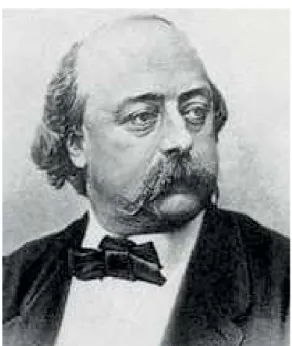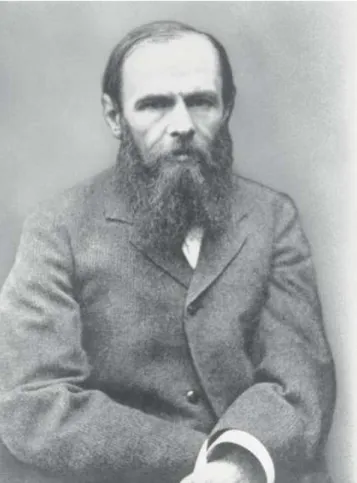892
https://doi.org/10.1590/0004-282X20170145 HISTORICAL NOTE
What do Flaubert, Dostoevsky and Machado
de Assis have in common with neurology?
O que Flaubert, Dostoevsky and Machado de Assis têm em comum com a neurologia?
Bruno Kusznir Vitturi1, Wilson Luiz Sanvito1
he Frenchman Gustave Flaubert, the Russian Fyodor Dostoevsky and the Brazilian Machado de Assis sufered from epilepsy and were afected by their neurological condition in diferent ways.
Gustave Flaubert (1821-1880) was the author of classic
masterpieces in history such as Madame Bovary (Figure 1).
In spite of his literary fame, Flaubert had epilepsy1. According
to historical accounts, his irst seizure occurred in 1844,
stun-ning his parents1,2. Epilepsy was a long way from been
under-stood, so an epileptic crisis aroused all sorts of speculation and stigmatization from the people around him. Even his father, who was a doctor, was “beside himself ” and tried vari-ous therapeutic means to heal his son: “he tried unsuccess-fully to bleed Gustave, he applied boiling water to Gustave’s
hand thus causing a painful second degree burn”3
. He would try many diferent treatments during his life: quinine,
bro-mides, plant infusions and drainages2,3.
His friend Maxime du Camp reported many of Flaubert’s crises: “Very often, distraught and powerless to intervene, I would witness his seizures, which were indeed terrifying to
1Santa Casa de São Paulo, Faculdade de Ciências Médicas, Disciplina de Neurologia, São Paulo SP, Brasil;
Correspondence: Bruno Kusznir Vitturi; Disciplina de Neurologia; Rua Dr. Cesário Mota Júnior, 112 / 3° andar; 01221-020 São Paulo SP, Brasil; E-mail: z_azul@hotmail.com
Conflict of interest: There is no conflict of interest to declare.
Received 08 July 2017; Received in final form 02 August 2017; Accepted 14 August 2017.
ABSTRACT
The Frenchman Gustave Flaubert, the Russian Fyodor Dostoevsky and the Brazilian Machado de Assis are known for their immeasurable contributions to literature. However, what most people do not know is that all three authors suffered from epilepsy and were affected by their neurological condition in different ways. We offer a short description of how epilepsy influenced their lives, how they dealt with it and how their neurological condition was present in their novels and correspondence. Their lives are excellent examples of how intimately neurology can be entwined in art and history, and provide an important perspective on patients with epilepsy.
Keywords: neurology; epilepsy; art.
RESUMO
O francês Gustave Flaubert, o russo Fyódor Dostoevsky e o brasileiro Machado de Assis são conhecidos pela sua imensurável contribuição para a Literatura. No entanto, o que a maioria das pessoas desconhece é que os três autores sofriam de epilepsia e foram, de diferentes maneiras, afetados por sua condição neurológica. Nós fazemos uma breve descrição de como a epilepsia influenciou suas vidas, como eles lidaram com a doença e como sua condição neurológica estava presente em seus romances e correspondências. Suas vidas são excelentes exemplos de quão íntima pode ser a neurologia da arte e da história e fornecem uma importante visão sobre os pacientes com epilepsia.
Palavras-chave: neurologia; epilepsia; arte.
Figure 1. Gustave Flaubert (1821-1880), the author of
893
Vitturi BK and Sanvito WL. Three famous authors connected by neurology
see. […] Abruptly, without any reason, Gustave would raise his hand and become very pale; […] His eyes would be full of anxiety and he would hunch his shoulders in a distressing and discouraging movement. […] hen the convulsion would take
him over”3
.Flaubert also described the epileptic auras
him-self: “I have a lame in my eye; everything is tinged with gold”. Epilepsy became a part of his life, as did the sufering caused by it. His illness made him abandon his studies in law causing him to become increasingly isolated from people and society. He always felt embarrassed by his medical condition, and the
prejudices toward the epileptic at that time were undeniable2,3.
So much so, that there is no description of his convulsions in his literary output and, when Flaubert spoke about his attacks, he called them “nerve sickness” or used other euphemisms. However, it is certain that his illness had inluenced his iden-tity as a writer and it reinforced Flaubert’s literary inclinations: “I have an outlet […]. he paper is here and I am relieved”,
wrote Flaubert, referring to his epilepsy3
.
Fyodor Dostoevsky (1821-1881), one of the most impor-tant Russian writers in history, also sufered from epilepsy (Figure 2). Dostoevsky was sentenced to four years of forced labor in a Siberian prison after being accused of distributing printed works directed against the government. However, one
could say that epilepsy “saved” him – the author of he Idiot
managed to convince the military, in which he was forced to serve indeinitely, that retaining an army oicer with epilepsy (a mysterious disease) was extremely dangerous, and he was
discharged of the army4. Another interesting and notable point
of Dostoevsky’s epilepsy was that he probably sufered from ecstatic aura, the existence of which was previously unknown. He often described sudden and unanticipated psychological states characterized by vivid memories and a pleasant sensa-tion near ecstasy. hese epileptic auras somehow justify his
seminal idea that a moment of happiness is worth a lifetime4,5.
Unlike Flaubert, epilepsy was present in at least six of Dostoevsky’s characters. In fact, epilepsy occupied a prominent position in his novels, in that the seizures were richly depicted and even helped in the construction of the personality of the
characters4,5,6. In he Brothers Karamazov, for instance, a
char-acter with epilepsy simulates one of his crises in order to not
be accused of a murder that he committed6. Dostoevsky
incor-porated his own sufering into his art and acknowledged the therapeutic efects that literature had on his health, although writing was repeatedly contraindicated by his doctors. Several times, Dostoevsky was skeptical about the prescribed treat-ment (bromides), although he had repeatedly sought the
opin-ions of great neurologists, such as Moritz Romberg4,5,6.
Machado de Assis (1839-1908) is considered the most famous Brazilian writer (Figure 3). His seizures began in infancy and accompanied him his whole life. He probably sufered from temporal lobe epilepsy with complex partial seizures
that were secondarily generalized7
.Like Flaubert, Machado de
Assis never felt comfortable with his epilepsy and always tried to hide it. he word “epilepsy” or its derivatives only appeared in
his literary texts in the irst edition of he Posthumous Memoirs
of Bras Cubas, after which the word was deleted in all the other
editions8. Similarly, in 1872, Machado translated a booklet, by
Figure 2. Fyodor Dostoevsky (1821-1881): author of the classic
Crime and Punishment.
894 Arq Neuropsiquiatr 2017;75(12):892-894
a French doctor, Hygiene for Schools and, curiously, he did not
save the word “epilepsy” here either. At that time, the ideas of the Italian neuropsychiatrist Cesare Lombroso were on the rise and epilepsy was associated with moral degeneration, insanity
and even a propensity for crime9. Machado’s epilepsy is only
dis-cussed in his correspondence with his friend Mario de Alencar
and even then, the author of Dom Casmurro often used the
euphemism “original sin” to refer to his neurological condition: “I am getting along well, except for the usual diiculties of old
age, and experiencing, without any change, the original sin”8,9.
Machado did not even share his neurological problem with his wife Carolina, who only discovered it when she witnessed a
sei-zure a few months after the wedding7,9.
As in Flaubert’s and Dostoevsky’s cases, treatment was not able to control Machado’s epilepsy so that, even
References
1. Gastaut H, Gastaut Y. La maladie de Gustave Flaubert. Rev Neurol. 1982;6-7:467-92.
2. Gastaut H, Gastaut Y, Broughton R. Gustave Flaubert’s Illness: a case report in evidence against the erroneous notion of psychogenic epilepsy. Epilepsia. 1984; 25(5):622-37. https://doi.org/10.1111/j.1528-1157.1984.tb03472.x
3. Jallon P, Jallon H. Gustave Flaubert’s hidden sickness. In: Bogousslavsky J, Boller F, editors.
Neurological disorders in famous artists. Front Neurol Neurosci. Basel: Karger; 2005. p. 46-56.
4. Iniesta I. Epilepsy in the process of artistic creation of Dostoevsky. Neurologia. 2014;29(6):371-8. https://doi.org/10.1016/j.nrl.2011.05.002
5. Iniesta I. Epilepsy in Dostoevsky. Prog Brain Res. 2013;205:277-93. https://doi.org/10.1016/B978-0-444-63273-9.00014-9
6. Voskuil PH. Epilepsy in Dostoevsky’s novels. Front Neurol Neurosci. 2013;31:195-214. https://doi.org/10.1159/000343236
7. Guerreiro CA. Machado de Assis’s epilepsy. Arq Neuropsiquiatr. 1992;50(3):378-82. https://doi.org/10.1590/S0004-282X1992000300020
8. Chapman AH, Chapman-Santana M. Machado de Assis’s own writings about his epilepsy: a brief clinical . Arq Neuropsiquiatr. 58(4):1153-4. https://doi.org/10.1590/S0004-282X2000000600029
9. Yacubian EM, Caboclo LO. Epilepsy and stigma: an approach to understanding through the life and works of the Brazilian writer Machado de Assis (1839-1908). Epilepsy Behav. 2011;20(3):465-70. https://doi.org/10.1016/j.yebeh.2010.12.040
though he consulted Dr. Miguel Couto, the most distin-guished Brazilian physician at that time, he described
himself as “a sick man without a doctor”8,9. When Machado
discovered that his contemporary, Flaubert, also suffered from epilepsy, he wrote: “I found the same solitude and
sadness, and even the same evil, as you know, the other”9.
In fact, epilepsy put Machado de Assis into a deep state of melancholy and solitude that some critics claim
contrib-uted to his artistic production7,8,9.

